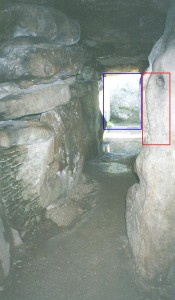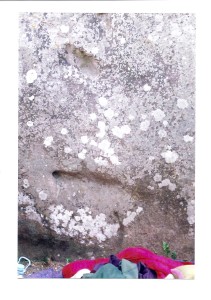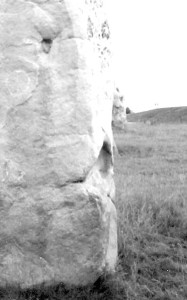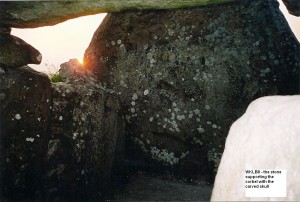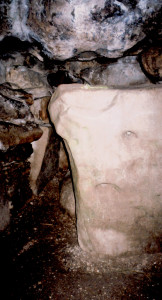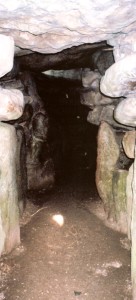Di Pattison
di@dipattison-artwork.co.uk
Keywords
Avebury, Neolithic, stonecarving, installation, illusion
Abstract
The discovery and analysis of a huge corpus of high-quality Neolithic stonecarvings at the Avebury World Heritage Site challenges modern presumptions about recent innovations in visual art and our current understanding of British Art History and Avebury’s archaeology. The paper discusses some of the most remarkable features of this sculpture and its associated architectural installations, namely its four-dimensional pieces created to be viewed in four distinct time-frames: the art created by manipulating captured light and shadow shapes, and carvings made specifically for dark places, rarely illuminated. The author illustrates the ancient Britons’ enjoyment of illusions and visual ‘tricks’ including the apparent crushing of time, flattening of space, and the concealment and revelation of images in moving light and shadow, suggesting the images held symbolic meaning integral to the purposes of the structures. She observes how ‘modern’ this stone-age interactive sculpture seems, and asks why the artworks have gone unrecognized for well over 50 years since the faithfully-restored sites were made fully accessible to the public. Could it be that we are better able to understand this imagery now in the light of very recent developments in the visual arts?
A challenging introduction
Audiences of the visual arts assume, reasonably enough, that works of visual art made long before fast-moving and ephemeral imagery were commonplace, were made to be seen, and can easily be recognized for what they are, especially by the cognoscenti.
Visual artworks in which viewers experience the sensation that time and/or space have been deliberately and intensely compacted are typically products of new digital media. In most cases, these vehicles and media are used to communicate ideas about the contemporary world.
This paper presents artwork that challenges those assumptions, as a new book by this author Avebury’s Stones: Selected Shaped Carved challenges conclusions drawn and assumptions made by archaeological scholars. A selection of the 170 stonecarvings and sculptural installations described in that volume is discussed here. Avebury’s corpus of sculptures and symbolic stonemasonry was created over a 1600-year period from c3800-2200BCE at the major monuments of this UNESCO-designated World Heritage Site close to Stonehenge in Southern England. The book discusses and catalogs discoveries made initially by archaeologist Alexander Keiller (in the 1930s), and Terence Meaden (in the late 1990s), but principally by myself since 2002.
This paper describes artworks that play tricks with human perceptions; images made for dark places rarely illuminated, images made from captured light and shadow shapes, and interactive four-dimensional sculpture and installations. It suggests they communicated symbolic meanings relating to religious and cosmological beliefs. Ancient Britons, many of whose hands can be identified individually, created them from the hardest rock in the country before metal tools were available. Their achievements will amaze you with their innovativeness, sensitive responsiveness, wit, and extraordinary ‘modernity’.
Background
Avebury is a village in Wiltshire. Within this village is Britain’s largest stone circle. The West Kennet avenue leading from it is its longest stone avenue, and the nearby West Kennet long barrow its finest and longest thus-far-excavated megalithic long barrow (that is, an earthen mound within which is a subterranean chambered tomb, outside which is a façade-forecourt-pathway structure, all built of large stones, many standing upright with others laid on top). The monuments are built of a local rock, sarsen, a limey sandstone that occurs as individual boulders lying on the grassy surface of this chalk downland scenery.
At Stonehenge, just 20 miles away, sarsen was worked to form the iconic trilithons or three-stone arches – rectangular pillars supporting both arc-shaped and straight lintels. They were built toward the end of Avebury’s long monument-building period.
The book Avebury’s Stones argues that at Stonehenge we see the flowering of ancient stonecraft in the form of stonemasonry, whereas at Avebury we see the flowering in equal magnificence of sculpture as an artform, using that term as we use it in the disciplines of Art and Art History. (The archaeological term Rock-art can be applied to any prehistoric engraving/sculpture, pictogram, earthen or stone image, artless or otherwise). Avebury’s sculpture was an integral aspect of its ceremonial and funereal architecture from the time many of the stones were first selected. The long barrow is the oldest of its monuments dating to about 3800 BCE, while the period of construction at Avebury extended through several phases from c2800-2200 BCE. A final phase of building at the barrow occurred at the end of this period. The monograph concludes with a statistical summary of findings, clearly demonstrating that over the centuries, as successive structures were built, increasing proportions of the surfaces of increasing numbers of stones became filled with increasingly sophisticated carved imagery. The origins of the Stonehenge stonemasonry techniques may be traced back even to the earliest building at the barrow.
Avebury’s Stones was originally commissioned by the small but internationally well-known scholastic publisher of archaeological material, BAR/Archaeopress of Oxford, following the success of a collaborative paper presented at a World Conference of specialists in prehistoric Rock Art in Lisbon in 2006. The paper was subsequently peer-reviewed and published by BAR in an edited volume in 2010. [1] Avebury’s Stones has however now been published by another company along with a smaller volume The shaped and carved stones of West Kennet long barrow.
After setting the discoveries in their European archaeological context, the Lisbon paper illustrated claims that the stones were worked with both stonemasonry and sculptural purposes, through detailed analyses of four examples. For example, we pointed out groups of toolmarks and telling signs left by the stoneworking processes, including gentle burning, plus the fracturing and chipping away of the rock under the impact of thrown and hand-held tools made from a locally-sourced iron-rich, even harder red sarsen variety, and with more distantly-sourced hardstone chisels, examples of all of which were found during excavations.
The Lisbon paper’s concluding paragraph described the astonishing ‘modernity’ of the sculptural imagery, suggesting that in the language of contemporary art, the monuments are site-specific land-art installations. The artwork is conceptual; often interactive and four-dimensional, with the images often deliberately positioned to capture the moving sunlight and changing shadows. In researching material for the book, the accuracy with which the monuments were excavated and restored in the 1930s and 1950s was checked and confirmed through a close study of detailed archives. We can be certain that, with only a tiny handful of possible exceptions, every stone now stands with its original top uppermost, facing the right way, and is set in (or extremely close to) its original socket.
Parts of these hitherto unpublished archives also provided further evidence of artificial shaping and stonedressing (or masonry), used sometimes to serve the practical purposes of erecting and balancing the great boulders safely, as well as aesthetic requirements such as smoothness/texture, measured dimensions, and the thoughtful positioning of some special natural feature within the artificially-produced silhouette.
The publishers and I therefore expect Avebury’s Stones to appeal to a wider audience than is usual for Archaeopress; particularly to artists, art historians, the contemporary art audience, social and architectural historians, Jungian psychologists and those interested in the psychology of perception, plus students/practitioners of ancient/reconstructed-ancient religion.
Be aware as you study the pictures presented in the Figures that these artworks are made with quite unsophisticated implements and techniques, not cut in soft stone that is/can be perfectly smoothed to resemble human skin; not free from some erosion; not cleaned up or conserved as for display in a gallery.
Nevertheless, crude as they may initially seem, the whole corpus demonstrates a keen interest by ancient artists in newly-emerging sciences such as the observation of the movements of the sun and moon, the proportions of the human head, of measurement and geometry; in how we perceive time and space; in natural likenesses; in abstract visual language, and in the employment of captured natural light and shadow to create illusions and time-related artworks. This will surely be of interest to the Leonardo readership.
Over and over I found myself spotting features that might resonate with Leonardo himself – such as a possible portrait of a sculptor’s patron, posing beside the head of a mythic character/deity in a composition; the use of geometry to create a design for a figurative group; the measured and compared/contrasted proportions of a diversity of human faces, heads and torsos, naked and clothed, that must have been taken from posing models, and then scaled up; the study of the body-form beneath tight and loose clothing…
I kept experiencing that profound sense of the crashing compression of time that Virilio called ‘dromology.’ [2] However, it was the consideration of the likely purpose of the artworks notwithstanding their seemingly modernity; the awareness that ancient audiences perhaps believed these artists had ‘shamanic’ powers; the tools and processes they used – that brought me back to a truer understanding of the enormous timescale separating us.
The paper now goes on to illustrate how these stone-age artists manipulated their audience’s perceptions of both space and time, suggesting why they did so.
Flattened space
There was never any ‘door-like’ stone to tightly seal the entrance of the long barrow tomb. Facing due east, the building was almost certainly designed in advance in the opinion of excavator Stuart Piggott, who referred to its ‘features of regularity’ and triangular groundplan facing east. [3] One ancient March or September morning the groundwork began. The architecture was set out on a hilltop site to precisely capture the equinoctial dawn light-beam down its 1 m-wide central gallery floor. When gazing outward from the deepest recesses of the tomb, the dark surroundings of the lintel-arch entrance and flattish-walled gallery stones would isolate a well-lit rectangular view of the semi-circular sun appearing on the flat horizon, and then gradually rising to reveal its full orb moving off on its southbound arc. The normal outdoor perception of that vista would appear strangely collapsed into a ‘dark-framed’ and seemingly two-dimensional light-filled ‘pictorial’ image, from which all non-essentials were deliberately excluded. With no pictures or picture frames as we understand them to refer to, though these people perhaps drew in some way to make their design, this must have been a strange perceptual phenomenon, as well as a religiously symbolic one to be ritually and attentively observed, marking the passage and cyclical nature of time. The metaphor of the light entering the tomb was of the fertilizing sun regenerating the ancestral bones within, ensuring they lived on forever in spirit form. This is also familiar in the later architecture of Irish passage tombs such as Newgrange, north of Dublin, documented by its excavator Michael O’Kelly and unquestioned by later scholars. [4]
A millennium and more passed. Then a new façade-like structure was built outside the tomb, incorporating a small central, open-air forecourt that would become the first British private ‘art gallery’, hidden from exterior view and accessed by a narrow concealed pathway. Large enough to accommodate only five or six adults closely seated at the most, it was a place where feasts were eaten, suggesting relaxed discussion in communion with ancestral spirits on key dates.
The old ‘picture-like’ view and outdoor world was deliberately closed off forever by the selection of a wide, 3,5 m-high boulder for the center front position. A mural was carved on the forecourt surface of this rock – we see it in its entirety in Figure 1a, viewed from the innermost part of the tomb, and in close-up in Figure 1b. It appears from a distance like a simple one-eyed giant face peering in. Whilst the stone is potentially large enough to contain a lot more of the figure, the mural was designed scientifically to fill the maximum space visible from this specific viewpoint and no more. Furthermore, although this is a tomb, there is abundant archaeological and architectural evidence that the interior was visited regularly by the living. For example, certain bones were sorted, some removed, some heaped, and some displayed in auspicious positions. Four of the five chambers, together with the gallery and lintel archway are high enough to stand in. After it ceased to be used however, the whole structure was carefully filled up with earth by the ancient folk. The human bones and artwork remained virtually undisturbed until the 1950s, meaning that the sculpture is in a state of excellent preservation today – and, following the monument’s refurbishment, is fully and freely accessible anytime.
The architecture deliberately ‘engineers’ a cognitive shift as visitors (then and now) approach the tomb entrance. A wide-open track between fields brings you to a little step at the far side of the building. This leads along a very narrow path behind the façade and emerges down a step into the forecourt, which is deliberately hidden from view until reaching its entrance. This is a distance of just a few meters, but in those moments one’s footsteps are slowed by deliberate obstructions, dark shadows, and the irregularities (originally) of a cobbled surface. Speech lowers to a whisper, and the mind quietens as people scramble to stand on the final step. From the forecourt would have come the smell of death. The dark interior seen through the archway arouses a sense of mystery and respect. Each footstep is by now very slow and deliberate. Inside the air is damper, the acoustic changes and the presence of supernatural energy and respected ancestors becomes apparent to the believer. Memories, fond emotions, and ancient stories would have come back to the minds of ancient visitors.
Passing into the gallery and looking back, the mural stone renders the exterior world invisible – out of sight and out of mind. Entering a permanent stone building in those days was entering an awesome ‘otherworld.’ Remember, these people did not live a settled lifestyle and dwelt in temporary timber shelters. This was subterranean, the ‘underworld’ realm of spirits, the building expressing this cosmological belief. The giant rock looks like another interior ‘wall’, yet it manages to do so without always making the visitor feel imprisoned because in summer at least, some light filters into the forecourt and outer gallery space.
The sculptor worked the entire image area (about 2 m x 2 m), when this boulder lay flat on the ground prior to erection. He or she flattened the ‘picture space’ in a virtuoso performance with a 25 mm-wide hardstone chisel blade, and then abraded selected areas even smoother, using a rubbing stone in a two-handed action from a kneeling pose adopted both on top of the stone surface itself as well as on the grass beside it. Such an action would have been familiar from the daily task of grinding corn on a saddle-quern, which simultaneously smoothed both saucer and rubber. The work included extending natural hollows to measured dimensions, to form the mouth and eye. As any simple face image would have ‘worked’ perfectly well without all that labor, the artist must have set out deliberately to make a very specially flat surface unlike any other in the entire monument complex. I conclude that this was to replicate the original ‘flat picture’ and the ‘wall-like’ sensations; the illusion that the mile-distant horizon and sky above it seemed somehow to exist on the same plane as the surface of the stone uprights and earthen floor formerly framing that view. Detailed analysis of all the stonework forming this second phase of construction demonstrates that at every step new elements were designed to honor the old. This collected information provides remarkable evidence that stories about the monument and its building/design had been passed down the generations for 1600 years. By alluding to this illusion the later artist manipulates the visitor’s perceptions in several ways, echoing the earlier and later manipulative effects of the architecture itself.
Secondly, the mural alters our perception of the relative sizes of the building and of ourselves. Like the cake-eating in Alice in Wonderland, this carved being could never enter the building. From the size of its head, its whole body would be almost 14 m tall. To it, therefore, the building would be like a doll’s house and the human visitor like a figurine it could pick up in two fingers. (Figurines were made across Neolithic Europe and carved here at Avebury from the local chalk, so the reference is to something very familiar). The artist thus diminishes the onlooker. First this ‘smallness’ is perceived as ‘magically’ changing one’s physical stature like Alice. Then comes the psychological ‘reduction’ in terms of feeling lesser self-worth in the presence of highly-regarded ancestors. Finally, after meditation upon this, comes the spiritual sensation of being ‘brought down to size’; humbled, awestruck and reverential, upon realizing that this one-eyed character is (probably) a representation of a very great sun-like deity, its flat full face replacing the sun in the ‘old picture’. The mural ‘picture’ prompts questions and makes the viewer imagine the invisible elements. What is the posture and nature of the figure? Is it bending double, lying on its stomach, standing under the ground or is this even the disembodied head of a well-known character who can appear and disappear at will? In this magical context anything becomes possible – the question for the moment remains unanswered.
On exiting, the carved being tempts you to draw close and inspect for signs of a second eye. Normal perception is resumed on return into the fresh air of the forecourt and the giant hugely rewards the carefully observant by revealing his expertly-worked but shallowly-carved left eye, seeming to share the enjoyment of all the discoveries with a wry smile, head tilted. The shaman-like artist thus establishes an extraordinarily pleasant interpersonal relationship between the ‘doll’ and its probable ‘maker’.
It is likely that the artist is cleverly representing an Odin-like deity about whom stories would be told and which survive today through many local place-names. One concerns the loss of an eye; another his magical powers and playing of tricks; a third his gender ambiguity, which is reflected in this image. The sculptor stimulates the retelling of his stories in the liminal forecourt area, and on the sunniest of days, as will later become evident.
Comparable heads are seen in Fourknocks passage tomb, also near Dublin, Ireland, and within the Avebury complex itself.
Visibility, invisibility and the compression of time
The following paragraphs explore various kinds of images in which four different time-frames are exploited sculpturally by the artists to manipulate the viewer’s perception of time – to make things seem to appear and disappear as if by magic.
Obviously, we must think of measuring time by Neolithic means. Some effects can be discovered in the blinking of an eye; some within the two minutes or less that it takes to walk ten slow steps in a semi-circle around a standing stone; some within ten minutes as shadows lengthen to their maximum – and, in the final example, beginning at dawn on midsummer morning and lasting three and a half hours until the sun has risen high in the sky.
Now you see it
Figures 2a, 2b and 3 show examples in which a single step and the passage of the sun across a stone surface quite suddenly reveal or conceal cleverly-made images.
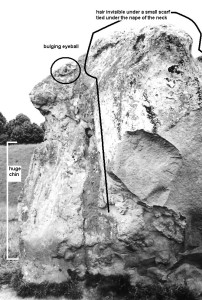
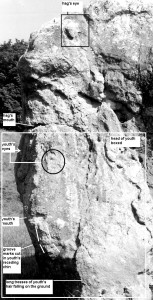
Figure 2 shows the left side of a huge standing stone in Avebury’s Great Circle. The front surface and left edge are filled by the 4 mhigh head in left profile of an archetypal hag with a much-exaggerated, square, and tightly clenched jaw. The stone is set in the earth in such a way that the neck-less chin seems to rest on the ground. We imagine its vast but invisible body below-ground; again the human is dwarfed in the presence of what appears to be an important character from a myth, (size being used throughout the architecture and corpus as a metaphor of importance and power). Its unrealistically-positioned, huge, wide-open and therefore somehow all-surveying eyeball is surely a metaphor for her supernatural all-knowing. The enormous chin and stern expression are almost certainly employed as metaphors of her fiercely protective and deterrent powers, and general strength of character, despite her obvious old age and femininity. It is one of seven heads in a highly complex composition reminiscent of Renaissance works – and appears to be an excellent example of an early narrative freestanding but plain-backed statue, the one also containing the probable ‘donor’ portrait.
Take one step towards that chin and turn a little to face the right and – suddenly – revealed within the chin is another concealed head, its top defined by her mouth. The emerging character is more realistic than archetypal in treatment, suggesting this represents a mortal. Visually, it is in every way the exact opposite of the other: male, young, smaller, rounder-chinned with the slightest of beards, softer-skinned, snub-nosed with tiny eyes. As her hair appears scraped back under some kind of practical headscarf tied at the nape, this head has masses of long wavy hair that cascade onto the ground and, when seen from another angle, he seems to wear a leafy wreath. In Jungian terms, the contrast is that of the animus and anima. It is not possible to see both heads, nor part of each head, at one time. It is as though the ancient sculptor was somehow familiar with Gestalt psychology! The metaphor and storyline surely is of some ancestral mythical character protecting a weak but important human youth. Perhaps, due to poor health or some disability, he especially needed this spiritual support, we are prompted to wonder.
Figure 3 shows the eastern side of one of the smaller megaliths, just over a meter high, it stands in a little-understood setting within the Great Circle. Two conjoined heads fill every surface of another example of an early statue-stone.
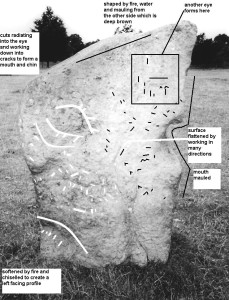
One head (annotated in white, with some examples of the tool marks also indicated) faces left, looking down with its mouth closed. Another figure, conjoined at the back of its head, (annotated in black), faces right, looking up, mouth open as if calling to a distant listener. The open-mouthed head is revealed in the early morning sun, a shadow filling its eye-hollow, while the southern end of the stone remains more shadowy. Then, around midday, the higher sun from the south illuminates the left-facing head and the eye of the first one is no longer shadow-filled. This stone was the first subject of experimental time-lapse film sequences made with photographer Pete Glastonbury to demonstrate the deliberate light-play. [5]
Two minute tricks
Walking up the avenue from the Great Circle, the edge of a tall stone seems from a distance like an enormous phallus. From the walkway, moving very slowly closer and round the pillar, looking up, the shape begins to widen. Taking another tiny step clockwise round it, the image changes into the three-quarter back-view of the head and neck of a young adult woman, looking leftward and down to the ground. Its tip becomes her forehead, crown and hair. Figure 4a shows her sharply pointed nose, round cheek, neck, and elaborately high-piled hairdo filling the entire stone, which stands about 3m high. Moving closer, still traveling clockwise, placing one heel in front of the other toe, she seems to age a little, as large dark cherry-like lips and an eye become visible. Continuing very slowly round in this conceptually-appropriate sun-wise/clockwise direction, she ages and re-poses, becoming a mature woman looking straight ahead after an arc of one hundred and eighty degrees. Turning back to face this image, her gaze remains firmly fixed straight ahead. The clarity with which you can see the changing form depends on the sunlight and season but is most effective around the midsummer solstice in the early morning, although even in overcast wintry weather the major changes are still evident.
At this point, the image seems to break down. The raised chin and a different, closed, straight, thin-lipped mouth are clearly visible. The portion of stone that formed the shapely younger lips is now part of her neck, a chunk having been carefully cut away after the localized burning which gave those lips their deep red-brown color. Her nose has fattened, become bent and misshapen as if broken in a fight. This is an Avebury convention – a means of tackling the difficult problem of forming a nose when a head is represented in a backward-turning pose – these noses always seem rather awkwardly bent. Here, this is exaggerated in an archetypal manner. Depending on the light, her eye can still be seen as a shadow. The hair is still styled the same way, but the chubby cheek has become sallow, the whole head thinner: she is ‘vanishing.’ The ‘broken’ nose is not evidence of damage to the stone but a visual metaphor employed by the sculptor to express the approach of death. It is repeated in other sculptures around the site. In those days, female life-expectancy was about 30 years, so she is now a very old woman.
Take one more tiny step and suddenly she fully re-emerges as the downward-gazing young woman. We now see her right cheek rather than her left (Figure 4b). It is as if she has followed us, rather than us following her. The concept of a never-ending cycle of life, death, re-fertilization and regeneration is being illustrated. It is also possible that the ancient Britons believed a diamond-shaped stone like this, set on its point, could physically turn like a spinning top – that the stone was understood as animate, the natural forms within the rock having inspired the artwork.
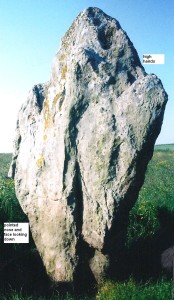
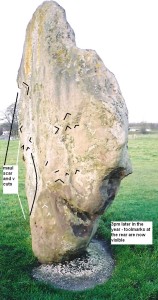
Another megalith shown in Figures 5a and 5b, located in the Great Circle, displays the slightly anxious face of a youthful beardless man in right profile (interpreted as youthful because the surface of the stone is tan-colored and smooth and interpreted as male because tall, and because of what we see next). Hidden in the shadow on the left side of the same surface is a conjoined left profile of a fat mature man with a full head of wavy hair and a long, thick beard. He becomes visible when the youth is in the shade – age and youth ‘coming’ and ‘going’ or ‘living’ and ‘dying’ with the light each day, rather like the woman on the previous stone. The natural process is speeded up so that a human lifetime is ‘magically’ reduced to considerably less than 24 hours.
Approaching the youth, whose head fills this equally tall stone, and again placing one heel infront of the other toe, looking carefully, and moving as if to meet him full face, his head begins to elongate vertically on the narrow edge of the very tall tabular stone. Looking more closely for signs that its nose has been broken away, it becomes clear that the figure never had a nose, and the artist aimed to keep the silhouette simple, smooth and tall. The device may be a means of communicating that this represents an ancestral or mythic figure or a personification of this life-stage rather than a mortal. The forehead extends and suddenly acquires a knob. We realize that the entire head has become a phallus, and we saw his ‘erection’ taking place in real time. Drawing closer, almost to a full-frontal viewpoint, the mouth opens asymmetrically at the far side and continues to do so as we move one more step. It is as if he makes a climactic shout. Then immediately as we continue moving, the whole image suddenly melts into the amorphous mass of the rear surface of the stone. We see instead the knowing grin of an old hag, who emerges equally suddenly at low level on the far edge of the rock, turning back to look at us over her shoulder, nose excessively bent, enjoying the joke with us. As we continue to walk round, she is revealed as a truly three-dimensional image occupying the corner of the megalith. And so we return to the starting point inside the Great Circle.
The color of the front of the stone was tanned by shallow firing, but at the rear it is the natural pale grey, glistening almost white in bright sunshine. This deliberate symbolic contrast of life/growth and death/decay expressed through the contrast of redder and whiter coloring is seen many times in the corpus, the stones being consistently set so that the dawn light enhances the tanned surfaces until they glow salmon-pink while the paler sides are set to face west – the metaphor being of pallor at the end of the day.
Ten minute shadow dramas
At dawn on the ancient early May cross-quarter-day festival, the shadow of a particularly tall pillar named the Oblelisk once standing like a gnomon in the center of an inner circle, lengthened on the ground towards an outer stone. The inner surface of this boulder carries a remarkably realistic, centrally-positioned, minimally-modified simulacrum of a super-size vulva, roughly proportionate in size to the dimensions of that shadow.
As it lengthens to its maximum, the shadow meets this stone, and appears to stand up vertically on its surface, covering the vaginal image. It is one among many examples of a symbolic representation of the act of coition. The shadow is as much an image as the stone simulacrum and the tall pillar-like Obelisk. Widely understood internationally, this expresses the familiar Greek myth of the hierogamy or ‘marriage’ of the ‘gods’ (sky god and earth mother). Their intercourse was the origin of all life at the dawn of time. May morning in ancient British lore is linked with fertility rites and the onset of full growth of crops/vegetation in these latitudes, and of human adulthood at puberty. In this small inner circle a number of other stones also appear to have been deliberately set as ‘calendar’ markers.
At the avenue, on every sunny afternoon in the ten minutes before sunset from early November to early February, the shadows of 24 stones on one side of the 18m-wide setting approach their partners opposite at an angle from the left – then moving to the right, meet, and stand up on their partners in a similar way, in a domino-falling sequence following down a gentle slope. There is just enough time to walk smartly up and down again to witness it before the shadow of a hill blankets the scene and the sun then sets behind it. The stones vary in height but it is clear that the shortest of them cast long enough shadows, so their height was an important factor in their selection, although they differ significantly in that respect.
At midsummer when the sun sets, the shadows fall from the north-west and at such an angle that the receiving stone is the southern neighbor of the partner stone opposite. At dawn the next morning the shadows fall the opposite way, linking the partner stones on the west side with the shadows of the eastern stones directly opposite. I therefore concluded that as the length of the shadow from the Obelisk – one of the earliest stones – played a part in determining the diameter of the inner circle later raised around it, so the shadow-lengths of the avenue stones played a part in determining the width and longitudinal stone-spacing of that structure.
Midsummer light installation and sculpture made for near-perpetual darkness
From just inside the lintel arch of the barrow tomb it is possible to see the sloping, upper left side of the great blocking stone hosting the face mural, described earlier. This has been deliberately cut at an angle by simultaneously throwing football-sized stones called mauls, worn spherical by repeated use, onto a line marked on the target stone placed flat on the ground. Carefully positioned, this then formed the right-hand side of a dark down-pointing triangular ‘window frame’ through which the only view one may observe from within the tomb is of the sky. The top of the ‘window frame’ is the underside of the lintel and the left side is formed by an exterior drystone wall-top behind which is a grassy bank – part of the long mound that was extended when the new extension was constructed. So this ‘frame’ exists in a deep 3D spatial context, not like a modern architectural window-frame.
Ordinarily this might be of little interest. But it must be seen at 4.50 am BST on June 21st from the point of view of a carved skull worked to fill one end of the first tier of corbelling positioned over a shaped and artificially fire-reddened upright portal stone (Figures 6a and 6b). This is located at the entrance to the first lateral chamber. Very special, this is one of our earliest sculptures and it is innovatively displayed on a purpose-made ‘plinth’ (the shaped stone tanned in the fire), all dating from c3800BCE. You must bend and turn your head sideways as the skull is lying on its right cheek as if sleeping.
Through the totally black, almost-perfect down-pointing isosceles triangle of the window, the sky becomes golden just before dawn. Then, exactly within its apex, in perfect proportion, the full intensely red circle dramatically appears (Figure 6). A captured triangular light-beam travels inward through the darkness, to land precisely on the face of the skull, which is a little larger than life-size. The sunray, like the long shadows, is a phallic symbol; the ‘window frame’ with the red orb, like a yoni.
In doing this, the artist replicates what has occurred moments before outside the building. For, filling the entire visible exterior portion of the 2m long lintel stone is a sculpture of the whole body of a seated animal, interpreted as probably a doe but maybe a calf, its head facing right. It is the earliest representational and high relief image carved on a lintel of a building in the British Isles, (dating to about 2200 BCE) so pre-dating the Lion Gate of Mycenae by approximately a millennium. Perfectly proportioned, observed from real life, originally smoothed and rounded (but now eroded), the head is shown as if just woken from sleep. The ear is slightly pricked up, a 30cm-deep carved cleft separating it from the head and body. The first light of the fully risen sun has landed on its muzzle and eye, tanning its otherwise grey coat, which remains in the shadow of the great blocking stone.
The sculptor almost certainly created this by working in situ on the original lintel of c3800BCE, standing on a small platform or ladder. The work has all the sophistication of the best late-dated works elsewhere in the complex, but pays homage to one of the very earliest works, the skull on its plinth. Whereas the skull ‘sleeps’ inside, this is a creature of the grassland, ‘sleeping’ outside. Verticality in the form of the uprights supporting the lintel, and the plinth-stone supporting the skull-stone, is contrasted with the horizontality of the lintel and the corbel. The standing stones thus act as metaphors of life while the horizontals symbolize sleep or death. The reddened sun-lit and fire-tanned surfaces are ‘alive’ while the grey surfaces/forms are ‘asleep/dead’. The symbolism is therefore again of the regeneration of life after death by the fertilizing sun.
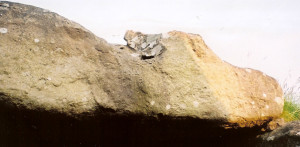
Within moments of touching the skull, the captured gold beam traverses to the top of the opposite portal stone. Slowly, it passes over its broad gallery-wall surface, lowering by 5.30 am as the sun rises and begins its southward journey. Initially the triangle has a slightly ragged shape (partly reflecting an imperfection of the window caused by the effects of footfall on the grassy bank in historic centuries, and partly by the slight unevenness of the receiving surfaces). Steadily though, it becomes a more perfect shape as it decreases in size and passes from stone to stone along the south side of the gallery. As it does so, gradually the ambient light begins to build.
Figure 8 shows the eerie effect as a carved face is illuminated in the first daylight. Made for this dark underground location, these summer mornings are the only times it can be inspected. Having few defined features but two eyes, nose and mouth on a flat light grey surface, this image has been worked on a stone used during or prior to the construction of the monument as a whetstone for sharpening/polishing hardstone axes. The nose, which is flat on top, is formed from the very smooth axe-polishing surface. Cuts have then been made into the stone to reduce the level between this area and the hollow right eye, representing the bone structure of the socket and brow. The stone top has been shaped to make an un-realistic hammerheaded crown and forehead. The face stares scarily across the gallery to the opposite chamber’s portal. Its non-representational elements, missing detail, and wide-open eyes, seemingly capable of maintaining surveillance in the darkness during the rest of the year, imbue it with otherworldly agency.
In what more powerful way might one express the idea, understood worldwide, that dried human bones somehow ‘live’ – than to make the top of an erected stone, especially in a tomb, resemble the end of a longbone planted in the earth, and to create a simple face on it? Here, selected longbones actually were arranged against the walls of the chambers, the familiar practice providing the inspiration.
As it passes over this stone the golden triangle of light – which astonishingly is, in Euclidian terms, almost precisely a ‘golden’ triangle – quite surprisingly changes from its obtuse ‘golden gnomon’ or yoni-like form into an acute form with its apex pointing (significantly, it seems) in its direction of travel to the depths of the tomb. This abstract visual language of pointing was understood without doubt by the ancients – there is abundant evidence of shaped pyramidal and angle-topped stones having been set at particular locations to direct the eye to distant landscape and celestial features. Perfectly formed now, the yellow ‘arrow’ moves toward the ground, decreasing further in size as the sun continues to rise. It arrives at ground level beside the jambstone marking the entrance to the central final chamber.
In these special moments, the outer surface of this weird and irregular megalith, jutting awkwardly out into the gallery at its base, seems to look like a very large partial skull oriented vertically, its huge right ‘eye socket’ emphasized in deep shadow while the rest of the stone glows in the building daylight. The stone was very probably selected and erected in this way because of this strange natural simulacrum. The scary image has surely been deliberately set to impede the transit of unwary visitors and evil spirits across this final threshold by both physical and occult means – it is a familiar device in Irish tombs described by Twohig. [6] On the rear of this stone, deep in shadow, another small, carved face rather like the one described earlier, stares directly across the pathway through a huge single hollow eye. The deeper within the tomb the image lies the less light ever reaches it.
The yellow shape, still clearly distinguishable as an isosceles triangle, but now much smaller, continues to move slowly, coming to rest by 8 am right in the centre of the gallery floor, just outside the threshold of the innermost chamber as shown in Figure 9. Rather curiously, its shape has transformed again. Still a ‘golden’ triangle, its apex now points back outside.
For just ten minutes at the most, it draws our attention back to the entrance. Our view is of the face mural described earlier, which has become fully visible as the sun has risen and the shadows filling the forecourt have largely disappeared.
The triangle of light then suddenly vanishes as the sun rises too high for its beam to fall through the window, but now, at 8.15am BST, the rear wall of the western chamber becomes flooded with daylight for the first time.
Another carved, female face, just under 2 m-high, filling one of two stones forming the back wall of the building becomes visible to the giant figure who ‘arrived’ only a few moments ago and is peeking in from his late-dated forecourt mural. The female image is the earliest carved mural within a built structure in Britain, dating to c3800 BCE. It is a perfectly proportionate left profile, the chin seeming to rest on the ground. At all other times of the year it is concealed in total darkness. The giant prompts the retelling of another story – once people used to be able to see the lady at the equinoxes before ‘his’ stone was set up. The mural outside appears to have been made to honor the mural inside. Originally visitors would have to very carefully peer round the edge of the stone supporting the lintel to avoid casting their own shadow down the gallery at the equinoctial dawn and blocking their view of her. Here is another demonstration of the ‘trickery’ of the giant-who-knows-magic, reflected in that knowing grin. His pose and the angle of his face are finally understandable to the visitor inside. He is adopting the pose the earliest visitors adopted on the equinoctial mornings. The very creative artist enjoyed playing his or her clever trick, making the public interact with the sculpture in various ways more and less self-consciously.
Outside again, on another later-dated stone, placed auspiciously at the north end of the façade, a little head with what at first seems to be just one (right) eye and a downturned mouth, but no other features, stares skyward directly to the point where the risen midsummer morning sun is now visible high above and to the south, directly in its sightline. The sunbeam illuminates the shaped triangular plane of rock in which the single eye is cut. It is an illustration employing iconic motifs of the story of how a well-known character, portrayed repeatedly by different artists, lost the sight of the left eye. Again, upon very close inspection in the special angle of this midsummer morning sun, rising at its most north-easterly, the second eye is revealed, carved in the lowest of relief.
For me, this was the final moment of revelation – again coming with the immediate and awesome sensation that this ancient installation is so amazingly ‘modern’.
Conclusion
A long period of further research and contemplation followed.
Today, we are so familiar with fast-moving images that we are arguably too impatient; technologies having enabled us to be so all-seeing and yet at the same time so unobservant.
These monuments have been restored are now freely accessible to the public 24/7 since the late 1940s in Avebury’s case, and the late 1950s in the case of the long barrow. They are reportedly visited by about a quarter of a million people each year. [7] Which? Travel magazine voted the Avebury World Heritage Site the second-best heritage site in the world in January 2013 from the visitor’s viewpoint and all-round quality of the tourist experience. Thousands of web-pages add to the library of books and the Keiller museum and interpretation centre on site, presenting the many different aspects of the WHS. Yet this huge corpus of artwork has been completely invisible to everyone, including the excavators, more recent archaeologists, conservators, architectural historians, art historians and others. The presence of deliberately worked stones (axe-polishing stones excepted) has been denied by virtually every author ever to document the sites from the 17th Century until now.
Why? As explained, an archive of the excavator’s notes has remained unpublished, though even Keiller did not identify any carved figurative imagery. Isobel Smith, charged by his widow to write up Keiller’s work, did not herself believe his claims about the presence of worked stones. Subsequent writers have turned to her otherwise most scholarly and reliable account as a reference.
We have to learn how to see, to know when to look and from what viewpoints. Meaden recorded precisely in what lighting conditions and when, to the minute, he took his photos. He was patient and observant enough to notice that many images were revealed and hidden by the moving sun. However he did not prove they were works of sculpture, although he suspected it. Sightings of faces and other imagery in the stones were dismissed as fortuitous simulacra by academics and conservators. It is well-known that the natural stones do contain simulacra. Yet somehow, because seemingly fortuitous, the images within the monuments were judged inconsequential. Nevertheless, they were all ‘fortuitously’ standing upright as sculpture might. The possibility that they might have inspired sculptural modification was not considered seriously. No systematic inspection for evidence of stoneworking was ever published.
We can no longer ignore the images, because there are so many of them – my final count was over 170 containing toolmarks on 120 stones I studied. I determined the stones had been correctly repositioned. I investigated how this sarsen stone was worked at Stonehenge, and to make everyday tools like querns, which no one denies, from the publications and archives of archaeologist and quarryman Herbert Stone and his colleagues working there in the 1920s. The marks of the same tools and processes are abundant, and easily distinguishable from the marks of damage in historic centuries caused by metal tools.
The subject-matter of the Avebury corpus is utterly different from that of other Neolithic and Bronze Age rock art corpuses in Britain, and Western Europe – the unlikeliness of this being another reason for some to have denied its presence. It differs because the artists responded to the natural forms that occur in this stone and not in others. This responsive kind of art was not new however – it had its origins in petroglyphs within caves in Paleolithic France and Spain. Examples of the artform and period have also been discovered at Creswell in Central England in recent years. Avebury’s artwork also springs in part from the special local and also widespread European traditions of making figurines and is to an extent eclectic in displaying influences from the rock art of Northern Britain, France and Ireland – this being an axe-tading centre attracting long-distance travelers from all over the UK as well as beaker folk from Western Europe.
We have been blind to irrefutable evidence of the naissance of sculpture in England here at Avebury. Enlightened by developments in contemporary art, we are perhaps now able to appreciate some of its most remarkable qualities.
Notes
[1] BAR stands for British Archaeological Reports. The conference was held jointly by UISPP, the International Union for Prehistoric and Protohistoric Sciences, and IFRAO, the International Federation of Rock Art Research Organizations. The paper, written with Terence Meaden and Kate Prendergast, cited below, appears in the BAR volume, Monumental Questions.
[2] Paul Virilio, Speed and Politics: an Essay on Dromology (New York: Semiotext, 1977), 47.
[3] Stuart Piggott, 1962: 15 —???– IS IT THIS ONE?: Stuart Piggott, The West Kennet Long Barrow Excavations 1955-6 (London: Her Majesty’s Stationery Office, 1965), 15.
[4] Michael J. O’Kelly, Newgrange – Archaeology, Art and Legend (London:Thames & Hudson 1982).
[5] Pete Glastonbury, “West Kennet Long barrow Equinox and Solstice,” YouTube video, 2:07, a video on experimental time-lapse sequences, showing the midsummer dawn light, posted October 2012, https://www.youtube.com/watch?v=rpcfjG4Itvw (accessed July 9, 2013).
[6] Elizabeth Shee, Twohig, The megalithic art of Western Europe (London: Clarendon Press, 1981), 139.
[7] Sarah Simmonds, ed., Avebury World Heritage Site Values and Voices (Devizes: Kennet District Council, 2008).
Credits
All photography is by the author.
Biography
Di Pattison has a BA in Fine Art, a Masters in Social Science, and an Art Teaching Certificate. She has over 20 years experience as an artist, exhibiting painting and sculpture in her early career while teaching, and then in business as an illustrator/designer. She also has many years experience as a researcher and manager working with housing organizations and of researching in connection with construction claims. In 2002 she returned to painting. It was to inform her studio practice that she began investigating the earliest roots of painting and sculpture in Britain. She read Terence Meaden’s The Secrets of the Avebury Stones, visited the Avebury site and began making her own discoveries that very day. Meaden and Kate Prendergast, whom she met about a year later on site, encouraged her to write. The book Avebury’s Stones selected shaped carved is the result of over 10 years work from that time onwards. In May 2013 she presented the paper The Avebury Corpus of Neolithic Southern England: sculpted heads, torsos, body parts, and abstract sexual symbolism at the International Federation of Rock-Art Research Organisations in Albuquerque NM, through the kind sponsorship of the American archaeological grantmaking foundation Commitment Inc. She is married and lives near Cambridge, UK, where she also has a studio, undertakes commissions and continues to exhibit internationally. For more information, visit www.dipattison-artwork.co.uk.

